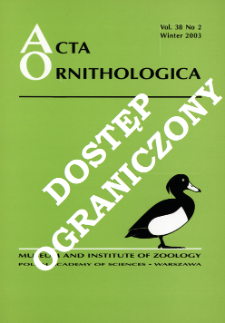
Object
Title: Reactions to human disturbances in an urban population of the swan goose Anser cygnoides in Heidelberg (SW Germany)
Subtitle:
Acta Ornithologica, vol. 38, no. 1 ; Reakcje stada gęsi łabędzionosych na antropogeniczne bodźce zakłócające w warunkach miejskich Heidelbergu (SW Niemcy) ; Disturbances in urban swan geese
Contributor:
Polska Akademia Nauk. Muzeum i Instytut Zoologii
Publisher:
Place of publishing:
Description:
Bibliogr. p. 51 ; P. [47]-52 : ill. ; 27 cm ; Abstract in Polish. Taxa in Latin
Type of object:
Abstract:
A total of 127 cases of disturbances were recorded, most of them resulting in not-too-serious reactions. An average disturbance affected 25 geese, occurred at 43 m distance to the cause and lasted 31-60 s. Geese feeding prior to the disturbance reacted more strongly than resting ones, and they were more sensitive to disturbances during the hatching and moulting/flightless period. More than fifty percent of the disturbances were caused by dogs they affected significantly more geese, caused longer durations of disturbances, and probably higher energy costs. There were highly significant positive correlations between a reaction, the duration of a disturbance and the number of geese affected. However, distance to the waterline correlated only with the number of geese affected. Distance to waterline and distance to the source of the disturbance had a high impact on the number of geese affected in a regression model. When disturbances occurred at greater distances, these were more serious, lasted longer and affected more geese. Separate analysis of the dogs demonstrated the influence of dog size (the larger the dog, the greater the disturbance), but not whether it was on a lead. Fleeing into the water was caused by dogs more often than expected. Habituation to an urban environment and predictions for fleeing behaviour are discussed.
Relation:
Volume:
Issue:
Start page:
End page:
Detailed Resource Type:
Format:
Resource Identifier:
Source:
MiIZ PAN, call no. P.257-38-1 ; MiIZ PAN, call no. P.4568-38-1 ; click here to follow the link
Language:
Rights:
Rights Reserved - Restricted Access
Terms of use:
Digitizing institution:
Museum and Institute of Zoology of the Polish Academy of Sciences
Original in:
Library of the Museum and Institute of Zoology of the Polish Academy of Sciences
Projects co-financed by:
European Union. European Regional Development Fund ; Programme Innovative Economy, 2010-2014, Priority Axis 2. R&D infrastructure
Access:
Object collections:
- Museum and Institute of Zoology PAS > Scientific Journals
- Museum and Institute of Zoology PAS > MIZ PAN Publications > Acta Ornithologica
Last modified:
Oct 2, 2020
In our library since:
Jun 10, 2014
Number of object content downloads / hits:
50
All available object's versions:
https://rcin.org.pl/miiz/publication/55591
Show description in RDF format:
Show description in RDFa format:
Show description in OAI-PMH format:
Objects Similar
Lewartowski, Zenon Stawarczyk, Tadeusz (1952– ) Winiecki, Aleksander (1956– )
Engel, Jacek Keller, Marek Leszkowicz, Jan Zawadzki, Jerzy
Ebbinge, Barwolt Sijbrand (1949– ) Biezen, Johan B. van
Kazulìn, Alâksandr Vasìl'evìč
Schmidt, Günter (zoologia ; 1928- )
Zając, Ryszard Zygmunt (1936– )
Habitat choice of steller's eider Polysticta stelleri wintering at Lithuania coast of the Baltic Sea
Žydelis, Ramunas
Gromadzki, Maciej (1940– ) Wieloch, Maria

 INSTYTUT ARCHEOLOGII I ETNOLOGII POLSKIEJ AKADEMII NAUK
INSTYTUT ARCHEOLOGII I ETNOLOGII POLSKIEJ AKADEMII NAUK
 INSTYTUT BADAŃ LITERACKICH POLSKIEJ AKADEMII NAUK
INSTYTUT BADAŃ LITERACKICH POLSKIEJ AKADEMII NAUK
 INSTYTUT BADAWCZY LEŚNICTWA
INSTYTUT BADAWCZY LEŚNICTWA
 INSTYTUT BIOLOGII DOŚWIADCZALNEJ IM. MARCELEGO NENCKIEGO POLSKIEJ AKADEMII NAUK
INSTYTUT BIOLOGII DOŚWIADCZALNEJ IM. MARCELEGO NENCKIEGO POLSKIEJ AKADEMII NAUK
 INSTYTUT BIOLOGII SSAKÓW POLSKIEJ AKADEMII NAUK
INSTYTUT BIOLOGII SSAKÓW POLSKIEJ AKADEMII NAUK
 INSTYTUT CHEMII FIZYCZNEJ PAN
INSTYTUT CHEMII FIZYCZNEJ PAN
 INSTYTUT CHEMII ORGANICZNEJ PAN
INSTYTUT CHEMII ORGANICZNEJ PAN
 INSTYTUT FILOZOFII I SOCJOLOGII PAN
INSTYTUT FILOZOFII I SOCJOLOGII PAN
 INSTYTUT GEOGRAFII I PRZESTRZENNEGO ZAGOSPODAROWANIA PAN
INSTYTUT GEOGRAFII I PRZESTRZENNEGO ZAGOSPODAROWANIA PAN
 INSTYTUT HISTORII im. TADEUSZA MANTEUFFLA POLSKIEJ AKADEMII NAUK
INSTYTUT HISTORII im. TADEUSZA MANTEUFFLA POLSKIEJ AKADEMII NAUK
 INSTYTUT JĘZYKA POLSKIEGO POLSKIEJ AKADEMII NAUK
INSTYTUT JĘZYKA POLSKIEGO POLSKIEJ AKADEMII NAUK
 INSTYTUT MATEMATYCZNY PAN
INSTYTUT MATEMATYCZNY PAN
 INSTYTUT MEDYCYNY DOŚWIADCZALNEJ I KLINICZNEJ IM.MIROSŁAWA MOSSAKOWSKIEGO POLSKIEJ AKADEMII NAUK
INSTYTUT MEDYCYNY DOŚWIADCZALNEJ I KLINICZNEJ IM.MIROSŁAWA MOSSAKOWSKIEGO POLSKIEJ AKADEMII NAUK
 INSTYTUT PODSTAWOWYCH PROBLEMÓW TECHNIKI PAN
INSTYTUT PODSTAWOWYCH PROBLEMÓW TECHNIKI PAN
 INSTYTUT SLAWISTYKI PAN
INSTYTUT SLAWISTYKI PAN
 SIEĆ BADAWCZA ŁUKASIEWICZ - INSTYTUT TECHNOLOGII MATERIAŁÓW ELEKTRONICZNYCH
SIEĆ BADAWCZA ŁUKASIEWICZ - INSTYTUT TECHNOLOGII MATERIAŁÓW ELEKTRONICZNYCH
 MUZEUM I INSTYTUT ZOOLOGII POLSKIEJ AKADEMII NAUK
MUZEUM I INSTYTUT ZOOLOGII POLSKIEJ AKADEMII NAUK
 INSTYTUT BADAŃ SYSTEMOWYCH PAN
INSTYTUT BADAŃ SYSTEMOWYCH PAN
 INSTYTUT BOTANIKI IM. WŁADYSŁAWA SZAFERA POLSKIEJ AKADEMII NAUK
INSTYTUT BOTANIKI IM. WŁADYSŁAWA SZAFERA POLSKIEJ AKADEMII NAUK
































